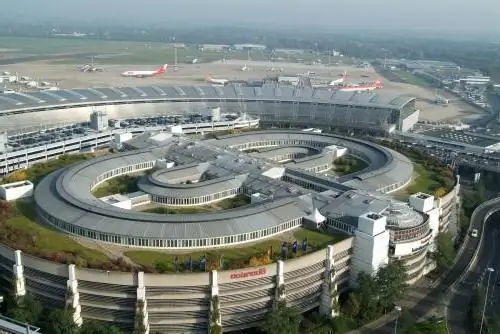- Author Harold Hamphrey [email protected].
- Public 2023-12-17 10:06.
- Last modified 2025-01-24 11:10.
Koblenz is a German city, the third largest in Rhineland-Palatinate. About 110 thousand inhabitants live here. The city is over 2000 years old, making it one of the oldest in Germany. Its name comes from the Latin concept Confluentes, meaning "merging." So it was named due to its location - on the territory of the junction of the rivers - the Rhine and the Moselle.

History
At first it was a fortified camp, which was founded by the famous Roman general Germanicus. But then the Romans built a strong fortress with 19 towers on this site.
In the 5th century, the city became part of the state of the Franks - the largest and most powerful kingdom in Europe, uniting almost the entire territory of today's France and Germany. The city already had a royal palace, and after the adoption of Christianity by the Franks, the first churches were built.
Koblenz Attractions
The Basilica of St. Castor is the dominant city temple, founded in 836. The remains of the monk Saint Castor were brought to the built temple in 837, and since that time the saint has been called the patron saint of the city. The basilica was often completed and rebuilt - first it was a Romanesque basilica, then a classical cathedral ingothic style. It was completely completed by the middle of the 15th century. In the XX century the temple was destroyed during the Second World War. The current building is a historical reconstruction recreated in the post-war period.
In the 14th century, a bridge over the Moselle was built in the city, which today has become another attraction. The stone bridge, built in the 14th century, has been perfectly preserved to this day.
Another interesting attraction is the stone fountain, erected here by Napoleon in honor of the future victory over Russia. Victory did not happen, but the fountain remained.
Rhine and Moselle at the confluence form an acute angle, a spit, which is called the "German angle" or "German triangle". This is the most important and most popular place in the city, it is a pointed triangular protrusion of the embankment, decorated with a majestic statue of William the First on horseback, the emperor of united Germany.

In 1945, the statue was destroyed. After the end of the war, this place began to symbolize the revival of Germany: there was a memorial sign surrounded by flags of all regions of Germany, and only by 1993 the monument to Wilhelm was completely restored. Today it is also a cultural monument included in the UNESCO list.
Another remarkable place is the Ehrenbreitstein Fortress, built in the 10th century. By the 19th century, the fortress building was almost completely rebuilt, and before the creation of modern heavy artillery, it was one of the most powerful fortifications in Europe. Today there is a museum that tells about the history ofregion.
Tourists should visit a large private museum dedicated to the famous composer Beethoven. Germany, Koblenz is the birthplace of his mother, the house where she was born has been preserved here. The museum has a rich exposition, as well as completely restored interiors of the middle of the 18th century, which Germany is so rich in. Koblenz is a city with many attractions that must be seen and visited. However, this can be said about every city in this country.
Modern Germany

Koblenz is one of the important centers of tourism in the west of the country. The main buildings are made in the Baroque style: the city had to be almost completely rebuilt after the difficult Thirty Years' War of the 17th century, and then reconstructed again after the Second World War. But it has Romanesque, Gothic and Baroque churches, an old university building.
There are many funny monuments in the city. For example, the Joker Fountain is a bronze figure spitting water every few minutes.
Many river routes depart from Koblenz along the Rhine, on the coast of which there are many beautiful castles. The streets are peaceful and cozy, there are many souvenir stalls, shops, restaurants and bars. It is worth tasting the local wines. The city is located at the junction of two major wine regions in Germany.

Conclusion
One of the most interesting countries in Europe is Germany. Koblenz is one of the oldest German cities worthy of the attention of tourists. There are manymonuments, landmarks and places of interest. And photo shoots against the backdrop of picturesque views of the city in the Rhineland-Palatinate will take their favorite places in the albums and memory of travelers.






